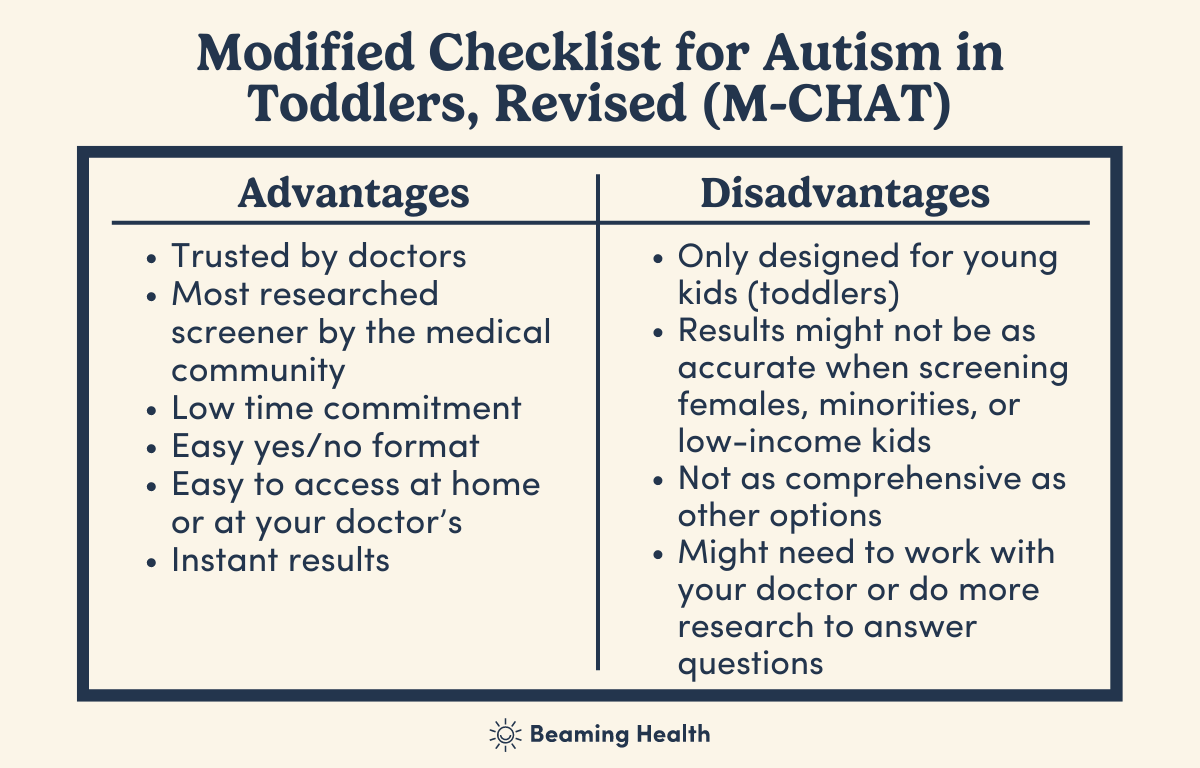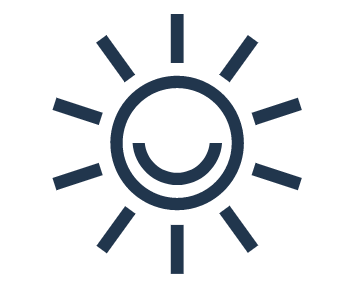Best autism tests and screeners for kids
Updated: November 9, 2023 · 8 Minute Read

Reviewed by:
Nonyé Nwosu-Kanu, Ph.D.
Highlights
- Autism screeners developed for children are evidence-based tools and assessments. These screeners help parents and professionals identify autism and any developmental delays.
- The M-CHAT and CAST are easy to complete at home for free. You might need to work with your doctor or do more research to accurately answer some questions.
- There is a free app called ASDetect that shows detailed videos to help better understand signs of autism.
- The ASQ is not an autism screener, but it can help healthcare providers and parents identify autism in children by providing a broader picture of developmental skills, delays, and concerns.
- There are more comprehensive autism screeners like the SCQ and SRS, but parents will need to work with a licensed professional to access them.
The 6 best autism tests and screeners for kids
There are many different autism screeners available that vary in length, cost, and approach. Here are the most recommended autism tests and screeners used today...
The most popular and well-studied autism test for young children. Modified Checklist for Autism in Toddlers, Revised (M-CHAT)
Best for ages 16-30 months | 20 yes or no questions | 10 minutes
The M-CHAT is one of the most researched and accessible autism screeners you can take for free online. Many pediatricians use the M-CHAT to screen toddlers for autism too. Questions are based on common autistic traits and behaviors, focusing on your child’s language abilities, movement, emotions, and thinking skills.
If you take the screener at home and receive a medium or high risk result, bring your completed screener to your pediatrician. If it’s a low risk, keep tracking your child’s development closely —if anything changes or concerns linger, get a consultation with a developmental specialist. Though officially designed for children ages 16-30 months, older children can also use the screener as a baseline to help provide more information specific to the child’s behavior and needs.
Though revised versions of the M-CHAT have improved in accuracy throughout the years, it may not be as effective when screening autistic females and minority, low-income children.2 If you have any concerns, work through an alternative plan with your care team.

The autism test for school-age children. Childhood Autism Spectrum Test (CAST)
Best for ages 4-11 | 39 yes or no questions | 20 minutes
The CAST is another free autism screener that was specifically developed for young students. Similar to the M-CHAT, bring your results to your pediatrician if you receive a medium or high-risk score. Keep track of your child’s development closely if you receive a low-risk score. Studies show that CAST in Spanish is also reliable for Hispanic families.3
.png)
The free autism app test for toddlers. ASDetect
Best for ages 11-30 months | ~15 multiple choice questions depending on age group | 30 minutes
It’s a resourceful and completely free app! There are short, detailed videos for every question so that you can see real-life examples. A question about eye contact will explain what it is and show you what an autistic child with no or little eye contact looks like. The app is based on research done at an Australian University. You can only access the app if your child is between the ages of 11-30 months.
.png)
The general development test for young children. The Ages and Stages Questionnaire (ASQ)
Best for ages 1 month to 5 and a half years old | ~21 multiple choice questions and 9 free-form questions | 15 minutes
The ASQ is the most popular general developmental screening tool. ASQ is not an autism screener, but it can help healthcare providers and parents identify signs of autism in children by providing a broader picture of developmental skills, delays, and concerns. Many pediatricians and medical professionals use ASQ because they are able to freely access it (no license is needed to administer the test). You can access a free, online version of the ASQ here, but the results and any recommendations may take several weeks. There are a different set of questions based on different age groups. Depending on your child’s age, props might be needed if you complete a screening at home or at the clinic.
.png)
The autism specialist’s test. Social Communication Questionnaire (SCQ)
Best for ages 4 and older | 40 yes or no questions | 15 minutes
The autism-focused SCQ examines a broad range of communication and social skills, but you’ll need to work with a licensed professional to access it. The SCQ can also be a part of a full autism evaluation, which may include the ADI-R (Autism Diagnostic Interview). Research shows that SCQ is more effective in identifying autism in school age kids and not as effective in toddlers.4,5
.png)
The autism researcher’s test. Social Responsiveness Scale (SRS)
For ages 30 months to 18 years old | 65 rating questions (from ‘not true’ to ‘almost always true’) | 20 minutes
The SRS is a popular autism screener that is more frequently used in research settings. The test requires a license for professional use and administration (similar to the SCQ). Parents, caregivers, teachers, and individuals can submit their responses to the questions via separate forms. Some providers use the SRS as an additional tool to help diagnose autism because of the extensive amount of standardized questions and behavioral information in the screener.
.png)
Next steps…
If your child is at risk for autism based on results from a screening, your doctor might refer you to a specialist for a clinical diagnostic evaluation. You can also find the best diagnostic evaluations covered by your insurance (along with waiting list times!) at Beaming Health.
Many of the resources and support available to children with autism require a diagnosis. For more information on the diagnostic process, check out our parent’s autism diagnosis guide.
Get our best articles delivered to your inbox each month.
We respect your privacy.
Dive Deeper
Article References
- Hyman S.L. et al. Identification, Evaluation, and Management of Children With Autism Spectrum Disorder. American Academy of Pediatrics. January 2020: 145(1). Accessed September 10, 2022. https://publications.aap.org/pediatrics/article/145/1/e20193447/36917/Identification-Evaluation-and-Management-of?autologincheck=redirected?nfToken=00000000-0000-0000-0000-000000000000#7411840
- Zwaigenbaum L. Maguire J. Autism Screening: Where Do We Go From Here? American Academy of Pediatrics. October 2019: 144(4). Accessed September 27, 2022. https://publications.aap.org/pediatrics/article/144/4/e20190925/38473/Autism-Screening-Where-Do-We-Go-From-Here?autologincheck=redirected?nfToken=00000000-0000-0000-0000-000000000000
- Morales-Hidalgo P. et al. The Childhood Autism Spectrum Test (CAST): Spanish adaptation and validation. Autism Research. April 2017: 10(9). Accessed October 14, 2022. https://pubmed.ncbi.nlm.nih.gov/28383173/
- Oosterling I. et al. How useful is the Social Communication Questionnaire in toddlers at risk of autism spectrum disorder? Journal of Child Psychology and Psychiatry. July 2010: 51(11). Accessed October 14, 2022. https://pubmed.ncbi.nlm.nih.gov/20626528/
- Marvin A.R. et al. Analysis of Social Communication Questionnaire (SCQ) Screening for Children Less Than Age 4. Current Developmental Disorders Reports. November 2017: 4(4). Accessed October 14, 2022. https://www.ncbi.nlm.nih.gov/pmc/articles/PMC5684265/
- Moody EJ, Reyes N, Ledbetter C, et al. Screening for Autism with the SRS and SCQ: Variations across Demographic, Developmental and Behavioral Factors in Preschool Children. Journal of Autism and Developmental Disorders. 2017;47(11):3550-3561. doi:10.1007/s10803-017-3255-5













